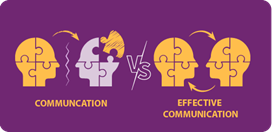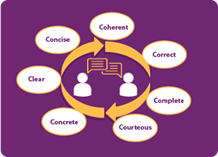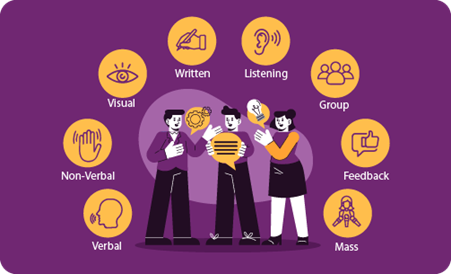Communication is the basis of all relationships. Why should it be any different when it comes to organizations?
It isn’t—in fact, it takes center stage. Communication establishes robust relationships, fosters long-term collaborations, and significantly impacts organizational success. It is the lifeblood of any organization.
What distinguishes leaders from the rest is effective communication.
While communication refers to the simple act of exchanging information, effective communication is the art of conveying messages clearly, concisely, and impactfully that drive action, build relationships and foster understanding.
For business leaders, mastering the art of effective communication is not just beneficial—it is essential for their and the organization’s success.
Verizon Digital Ready Provides the Free Skills Training Entrepreneurs Need
Distinguishing Effective Communication from Simple Communication
For a communication to be effective it needs to embody the 7Cs
This approach transforms basic information exchange into a powerful tool for achieving organizational goals.
Example:
- Simple Communication: Sending a company-wide email about a new policy.
- Effective Communication: Explaining the new policy in a clear, concise manner, outlining its benefits, and inviting feedback to ensure understanding and buy-in.
Why Effective Communication is Critical for Leadership
Leadership is not just about making decisions but about influencing and guiding others towards a common goal. Effective communication is critical for several reasons:
- Building Trust and Transparency:
- Open and honest communication helps Leaders create an environment of trust. This transparency fosters a culture where employees feel valued and are more likely to engage and contribute.
- Aligning Vision and Goals:
- Clear communication helps align the team’s efforts with the organization’s vision and goals. When leaders articulate the mission and objectives effectively, it ensures everyone is on the same page and working towards the same outcomes.
- Motivating and Inspiring:
- Effective communicators can motivate and inspire their teams. Leaders can boost morale and drive performance by sharing stories, recognizing achievements, and providing encouragement.
- Conflict Resolution:
- Inevitably, conflicts arise in any organization. Leaders who master effective communication can swiftly address and resolve disputes, ensuring minor issues do not escalate into major problems.
- Change Management:
- Effective communication is essential for smooth transitions in times of change, whether it’s organizational restructuring or adapting to market shifts. Leaders must be candid about the reasons for the change, the perks they bring, and the expected outcomes to get buy-in from their teams.
- Constructive Feedback:
- Constructive feedback is essential for growth. Leaders should provide specific, actionable feedback and focus on behaviors rather than personal attributes. Equally important is to encourage and be receptive to feedback from others.
7 Tips to Improve Your Business Communication Skills
The Impact of Effective Communication on Business
The impact of effective communication on business cannot be overstated. It permeates every aspect of an organization, from internal operations to external relations. Here’s how mastering this art translates into tangible benefits:
- Enhanced Team Performance:
-
- Clear and consistent communication fosters collaboration and teamwork, leading to higher productivity and better results.
- Stronger Employee Engagement:
-
- Employees who feel informed and listened to feel valued and, thereby, are more committed to their work. It helps up the loyalty antenna, improves retention, and fosters a positive workplace culture.
- Improved Customer Satisfaction:
-
- Effective communication with customers improves customer confidence and trust, which results in repeat business and positive word-of-mouth referrals.
- Improved Vendor Relations:
-
- Maintaining strong relationships with vendors requires transparency, mutual respect, and clear expectations, ensuring that both parties are aligned and can work together smoothly.
- Create a culture of Innovation:
-
- An open and communicative environment encourages employees to share ideas and explore creative problem-solving, creating a culture promoting innovation.
-
- With clear communication, leaders can make more informed decisions based on accurate and comprehensive information.
-
- Organizations that communicate effectively are better equipped to handle crises, mitigate damage and recover more quickly.
Strategies for Leaders to Adopt for Effective Communication
1. Clarity and Conciseness:
-
- Ensure messages are clear and to the point. Avoid jargon and complex language to prevent misunderstandings.
2. Active Listening:
-
- Fully engage with the speaker and show genuine interest. Reflect on what you’ve heard to confirm your understanding. For example: When a team member raises concerns about a project timeline, a leader demonstrates active listening by giving full attention, maintaining eye contact, and summarizing the issue to ensure clarity. By asking probing questions and confirming understanding, the leader shows genuine interest and follows up with action, keeping the team informed of any adjustments made based on the feedback received.
3. Empathy and Emotional Intelligence:
-
- Understand and acknowledge the emotions behind the message. Respond with compassion and respect to build trust and rapport.
4. Open and Transparent Communication:
-
- Share information openly to foster trust and transparency. Keep your team informed about changes, goals, and decisions. For example: During a company-wide meeting about organizational restructuring, a leader openly discusses the reasons behind the changes, their expected impact on departments and individuals, and the anticipated benefits. The leader invites questions and provides honest answers to address concerns, committing to regular updates to keep everyone informed and aligned throughout the transition process.
5. Consistent Messaging:
-
- In today’s world, we use a mix of channels to communicate. To ensure clarity and receipt of messages in the desired manner, one needs to engage in consistent messaging across channels. Make sure to align your words and actions to reinforce your message.
6. Adaptability:
-
- We live in a world of diverse languages, education, backgrounds, and cultures; one needs to be aware of diversity, situations, the audience and tailor one’s communication style accordingly. Be flexible and open to feedback to improve your communication approach.
7. Feedback Culture:
-
- Encourage open feedback from your team and provide constructive feedback in return. Use feedback to make continuous improvements in communication. For example: To foster a culture of feedback, a leader schedules regular one-on-one meetings with team members to discuss progress and gather insights. By offering constructive feedback focused on behavior and encouraging upward feedback on leadership practices, the leader ensures that team members feel valued and that their input is integral to continuous improvement. Using tools like anonymous surveys further enhances transparency and facilitates actionable improvements based on received feedback.
8. Storytelling:
-
- To make messages more relatable and memorable, using stories to illustrate key points can be helpful. Compelling narratives help connect emotionally with your audience. For example: Imagine a senior manager sharing a story about a challenging project where the team faced numerous setbacks. They recount how the team, despite the odds, came together, brainstormed innovative solutions, and ultimately delivered a successful outcome. This story not only highlights teamwork and resilience but also inspires the current team to tackle their own challenges with confidence and creativity.
9. Body Language:
-
- We communicate via our body language, facial expressions, and tone of voice. Ensure your non-verbal cues align with your verbal messages.
10. Regular Check-Ins:
-
- Schedule regular one-on-one and team meetings to maintain open lines of communication. Use these opportunities to address concerns, provide updates, and foster collaboration.
11. Cultural Sensitivity:
-
- Be sensitive to cultural differences, be aware and respectful, and factor them into communication or language use. Adapt your communication to be inclusive and considerate of diverse backgrounds. For example: When meeting a Japanese colleague, instead of extending your hand for a handshake, you could opt for a slight bow to show respect for their cultural practice.
12. Use of Technology:
-
- Leverage communication tools and platforms to facilitate better collaboration. Ensure that technology enhances rather than negatively impacts effective communication.
SalesForce
AI + Data + CRM = more sales and happier customers.
Start or grow your business with the #1 CRM. Salesforce now has AI tools that helps you connect with your customers in a whole new way.
We earn a commission if you make a purchase, at no additional cost to you.
What Are the Different Ways a Leader Communicates?
Challenges that Ruin Effective Communication & Resolutions
- Misunderstandings and Misinterpretations:
- Solution: Ensure clarity and simplicity in your messages. Use straightforward language and avoid jargon. Confirm understanding by asking for feedback or summaries of what was communicated.
- Information Overload:
- Solution: Prioritize information and focus on delivering key messages. Break down complex information into digestible bites and provide summaries or highlights.
- Cultural and Language Barriers:
- Solution: Increase cultural awareness and sensitivity. Adapt your communication style to respect cultural differences and, where necessary, provide translations or language support.
- Emotional Barriers:
- Solution: Develop emotional intelligence. Recognize and address your own and others’ emotions during communication. Use empathy to connect and build trust.
- Resistance to Change:
- Solution: Communicate the benefits and reasons for change clearly. Take stakeholders in confidence, make them a part of the change process and address their concerns openly. Use stories and examples to illustrate positive outcomes.
- Lack of Feedback:
- Solution: Foster a feedback culture by encouraging open and honest feedback. Regularly seek input from your team and provide constructive feedback in return. Act on the feedback received to show its value.
- Inconsistent Messaging:
- Solution: Maintain consistency in your messages across all channels. Align your verbal and non-verbal communication and ensure your actions support your words. Create and follow a communication plan.
- Limited Communication Skills:
- Remote Communication Difficulties:
- Solution: Use reliable and efficient communication tools and platforms. Schedule regular virtual meetings and check-ins. Use video calls to maintain a personal connection.
- Maintaining Engagement:
- Solution: Use interactive and engaging communication methods. Incorporate storytelling, ask questions, and encourage participation. Recognize and address signs of disengagement promptly.
- Information Silos:
- Solution: Promote a culture of collaboration and open communication. Keep the information flowing across teams by employing collaborative tools and platforms. Encourage cross-functional meetings and interactions.
- Time Constraints:
- Solution: Prioritize communication activities in your schedule. Use time management techniques to ensure you have time for important communication. Delegate routine communications when appropriate.
Effective Communication in Startup Environments: 20 Tips from Leaders
Conclusion
In conclusion, effective communication is the spine of business leadership. It differentiates good leaders from great ones by enabling them to build trust, align teams, resolve conflicts, and drive innovation. In the dynamic landscape that we operate in, mastering the art of effective communication will remain a critical skill for leaders who aspire to lead their organizations to sustained success. By embracing and adapting to changing communication needs, leaders can ensure their messages are heard, understood, and acted upon, securing a competitive edge in an ever-changing world.
Image by freepik
What Is the Average Income of a Subway Restaurant Franchise Owner?
The post originally appeared on following source : Source link




